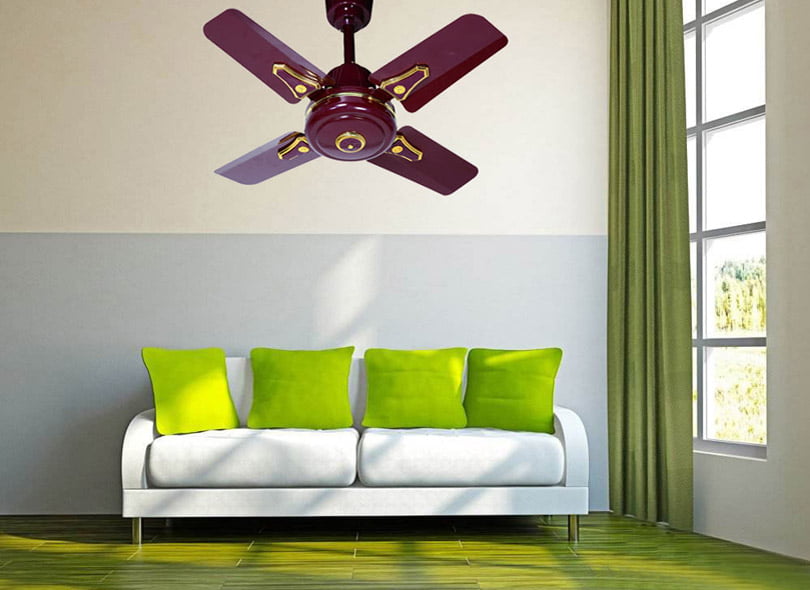Ceiling Fan is usually mounted on the ceiling in the home or outdoors. It’s the largest of all type of electric fan, which makes them advantageous for large area cooling. Read this ceiling fan guide to help you find the right one.
In This Ceiling Fan Guide 2023
• Functioning of Ceiling Fan
• Motor of Ceiling Fan
• Material of Ceiling Fan
• Benefits of Ceiling Fans for Outdoor Use
• Considerations When Buying a Ceiling Fan
• How to Installation Ceiling Fan
• Notes on The Installation of Ceiling Fans
• Maintenance and Cleaning of Ceiling Fan
• FAQ
• Summary
Functioning of Ceiling Fan
Ceiling fan is a kind of fan installed on the ceiling, which can promote airflow and make indoor air circulation not stuffy. Generally, there are two functions of forward rotation and reverse rotation during use:
●Forward rotation function: It rotates counterclockwise when looking up from the bottom and looking up. It can be used with air conditioners in summer. The downdraft generated can strengthen the indoor air-conditioning circulation and effectively reduce the temperature, improving the effect of air conditioning.
●Reversal function: Looking up from the bottom, it rotates clockwise, and the upward airflow generated can effectively convect the indoor air. In winter, it can be used with heating to make the hot air rise and effectively improve the indoor temperature.
Motor of Ceiling Fan
Depending on the motor structure, ceiling fans can be divided into DC and AC models.
DC ceiling fan: The fan use the magnetic effect of current to drive the shaft to drive the fan blades. They are more energy-efficient than AC ceiling fans, have no mechanical noise during operation, have a larger number of adjustable airflow sections and have a longer life span, but are more expensive than AC ceiling fans.
AC Ceiling Fan: The fans are simple in construction, have a stable airflow and are less expensive than DC ceiling fans, but they have a louder current when running.
Material of Ceiling Fan
Depending on the material, there are three main types of ceiling fans: wooden, plastic and iron.
Wooden: Wooden ceiling fans are common in homes, mainly with wooden blades and a retro appearance.
Plastic: Plastic ceiling fans are made of plastic injection, which is relatively cheap and has an avant-garde appearance.
Metal: The metal ceiling fans are mainly made of pressed metal and are mostly simple products for industrial use, with a simple and durable appearance.
Benefits of Ceiling Fans for Outdoor Use
1. Coolness and comfort. A covered terrace can have a stuffy or stagnant feeling when the air stops circulating. Extra lighting some outdoor fans with built-in light.
2. Extra lighting. Some outdoor fans have built-in light. This is useful if you want to use your outdoor space at night, as the light helps with safe operation.
3. Fewer pests. Rotating fan blades push the air as they spin, creating turbulence that insects and other flying insects don’t like. If they try to fly near you or your yard, they will be swept away by the breeze.
Considerations When Buying a Ceiling Fan
• Durability
The fan you install will need to be used for a long time, so it should be made of durable materials that can withstand harsh weather elements and changing seasonal temperatures. You can choose to be made from metal materials that are rust and corrosion resistant.
• Sizes
Sizes range from compact fans to oversized fans depending on what your specific space requires. spaces under 75 sq. ft. are best equipped with 29-36 inch. spaces between 76-144 sq. ft. are best equipped with 36-42 inch. outdoor areas between 144-225 sq. ft. are best suited to 44 inch. fans. Spaces larger than 225 sq. ft. require a 50″ or larger fan. Remember, the fan should not be lower than your head.
• Light
Choosing a ceiling fan with light can provide an additional source of light for your outdoor space. Look for one that is energy efficient and low maintenance. led lights are usually the best option. A remote control is great because you don’t have to get up every time you want to turn the lights on or off. The ability to dim the light is also beneficial as you can adjust the amount of light you have.
• Motor
Fans are labelled as either AC or DC motor types, which it has. AC motors use older technology, while DC motors use modern technology. This allows DC motors to be 77% more energy efficient without sacrificing performance. Both can be installed directly into your home’s electrical system, so you don’t have to worry about whether it’s compatible with your home.
• Style
The fan you choose needs to match your design aesthetic. There are thousands of options available, including ultra-modern, tropical, traditional, rustic or industrial. Choose a fan that complements the design of your home and the other decor you have outside. Take a look at the design of the main centre unit and blades.
How to Installation Ceiling Fan?
We have already shown you how to install and how to connect fan regulator in a previous article, which can be read in detail for links:
https://unitedstarcrown.com/how-to-install-ceiling-fan/
https://unitedstarcrown.com/how-to-connect-fan-regulator/
Notes on The Installation of Ceiling Fans
1. Hanging place needs to be able to carry more than 30 kg: Before installation, we must first judge whether the installation area is solid, and can carry more than 30 kg to be suitable for installation, generally recommended to be installed in concrete walls, with reinforcement and can withstand the weight of the interior decoration ceiling, to ensure the safety of subsequent use.
2. Blade end and wall distance of 60cm or more: ceiling fan fan blade end should be with the wall distance of 60cm or more, avoid installation in the corner, next to the beam column and other positions, to ensure the use of safety.
3. Fan blades need to be at least 250cm from the ground: ceiling fans are recommended to be installed at least 250cm from the ground to avoid excessive pressure or danger from being too close to the ground.
4. Avoid installation underneath lamps and lanterns: ceiling fans should be installed avoiding lighting underneath to avoid shadow shaking and affecting vision.
Maintenance and Cleaning of Ceiling Fan
1. Clean regularly: If too much dust accumulates on the ceiling fan it will affect the rotation speed and should be cleaned regularly every 2 to 3 months or so. Avoid using strong cleaning agents when wiping to avoid damaging the surface of the fan blades.
2. Use wood protection oil: Occasionally, you can apply wood protection oil to the fan blades to increase the protection.
3. Lock the screws regularly: After the ceiling fan has been in use for a period of time, the screws should be checked and confirmed regularly to ensure that they are locked tight.
FAQ:
Are Ceiling Fans Fashion?
Ceiling fans never go out of fashion because they are practical. They range in price from affordable to luxurious, which makes them suitable for people with a wide range of budgets. There is no better solution than this.
Are Ceiling Fans Worth Buying?
Yes! It is definitely worth buying. It will increase the comfort of your living space and make you more likely to use it. It will also add light to the area, making it safer and more functional during the night time.
Summary
It is important to choose the right size of ceiling fans, of course, their size and design will affect their price. Ceiling fans make life easier, especially in hot weather.
You can purchase Ceiling Fan on UnitedStar Crown.


